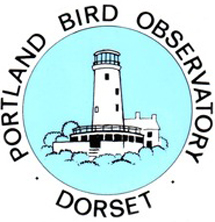Weekly round-up: 27 Mar - 02 Apr 2013
Another chilly week in which the Easter Bunny would have been delighted to be clad in fur....high pressure ~ a montser high pressure ~ continued to dominate the weather scene and although most places saw decent spells of sunshine the temperatures maintained a cool air as the high continually sucked in a brisk easterly airflow over the country.
To a degree it hindered the migrant arrival schedule, but the birds will come...they always do and it is still pretty early ~ we’ve only just sneaked in to April ~ so as much as birders want to shake off the winter and get cracking on spring, they may have to hold their horses for a wee while longer.
There were no head-turning first day of April highlights, but anyone reading some of the broadsheets at the weekend may have done a double take (and date check) when seeing the headline “Twitcher takes over as Head of MI5....” the mind truly boggles at some hilarious scenarios with a few well known lsiters in charge of all things security-wise.....
....anyway...with thoughts of spies and spooks keeping a crafty eye on what’s hot to trot in the World of Rares this week, we’ll trundle onwards, ever onwards, towards the birds of the week.
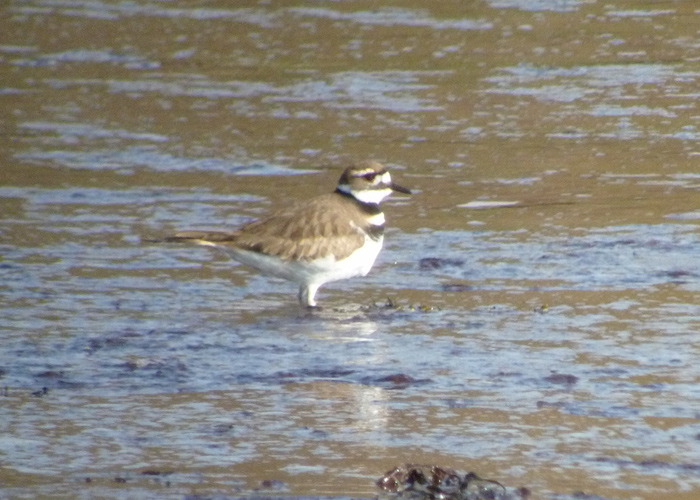
The two best birds of the week were in no way the rarest birds present around Britain and Ireland but they did refresh things somewhat and give renewed hope that a change was on the way.
First up, on Good Friday (it certainly would be a good Friday if you chanced upon it) was the Killdeer found at the north end of the estuary at Killybegs (Co. Donegal). Famously known far more for its larid pulling power, anyone who has paid a visit to the area will be well aware of how the Killybegs’ estuary always looks as if it could draw in a quality shorebird rarity ~ and its geographical position also points towards half a chance of producing something...
…and produce something it did ~ the first confirmed Killdeer in over two years (the most recent prior to this bird was one on Islay in January 2011) and it becomes a county first in to the bargain as well (and the 24th record for Ireland as a whole, from a grand total of 78 records in all).
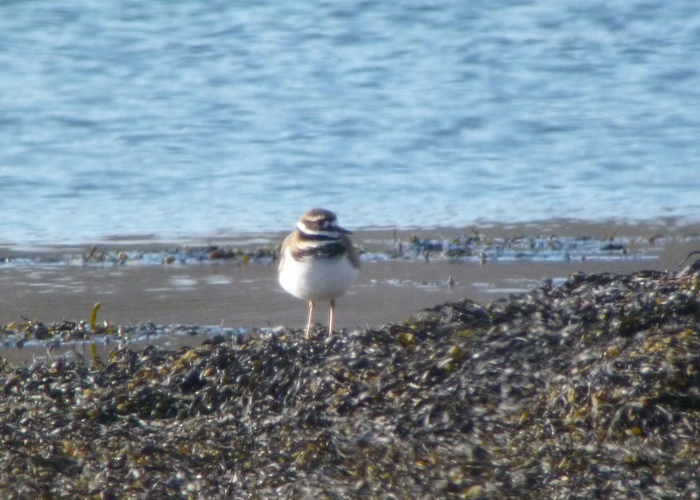
This will become the 12th Killdeer to be found in March ~ of the 11 previous records, two were seen in Cambridgeshire (in 1959 and 1976, the latter year seeing three birds appearing countrywide during the month) and two have also been found in Shetland in March as well (in 1993 and 2008). The most recent mainland March record was Norfolk’s first Killdeer, found around the edge of Breydon Water at the end of the month in 2005, a bird which returned almost a year later, on the north Norfolk coast at Blakeney Freshmarsh.
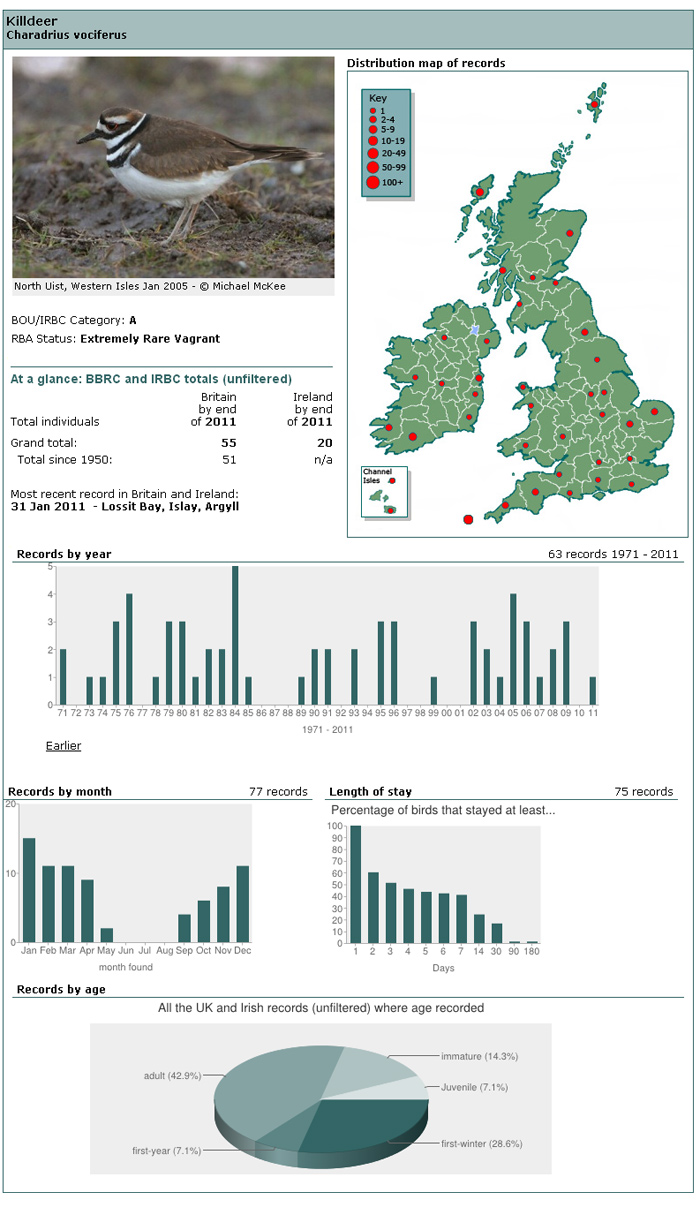
The long weekend’s other treat was the male Pallid Harrier seen in the area around Surrey’s Papercourt GPs on the afternoon of 31st. This becomes the second March record of the species, the first was the fabulous male found in west Cornwall on March 29th 2003 ~ a bird that (remarkably) then relocated to Spurn for April 1st and 3rd.
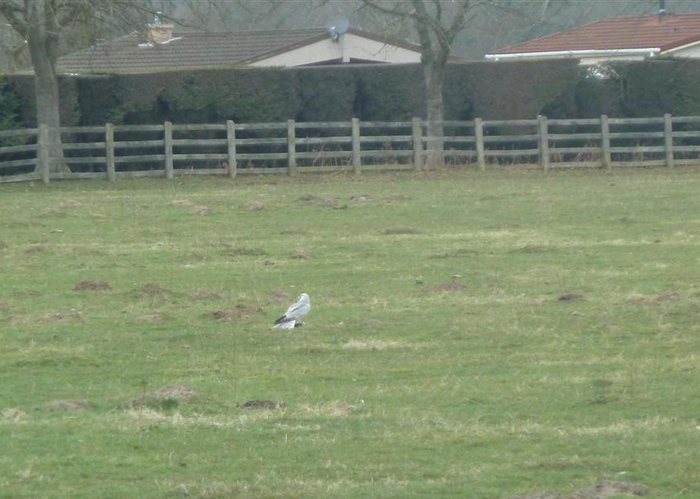
The rise of the once uber-mega has been well documented of course, but it is still hard to believe that it was only 20 years ago since the species was recorded in twitching’s modern-day ~ an amazing five birds were found in 1993 (only the 4th to 8th records ever), though it wasn’t until 1995 that Britain’s listers really got the chance to unblock this fabled species, thanks to the summering 2nd year male on Orkney.
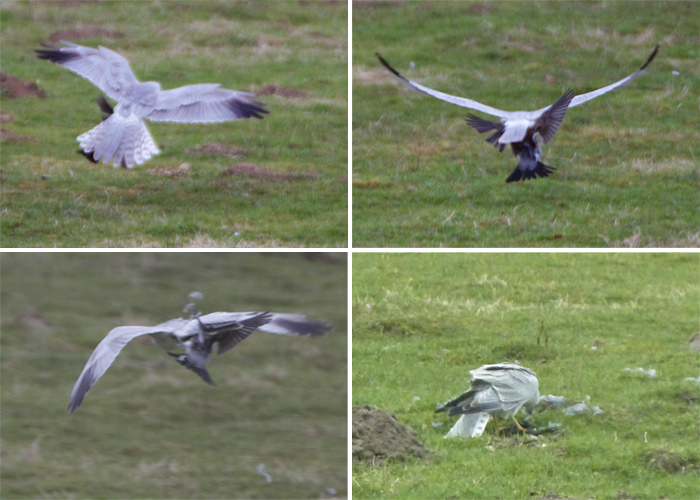
Now, the species is regarded as an annual visitor ~ since 2001 there has only been one blank year for Pallid Harrier here (2008) and there are now 64 accepted records.
Last week’s little breath of fresh rarity air, the super first-winter male Black-throated Thrush at Banchory (Aberdeenshire) did a bunk sometime during the day of 27th ~ present and correct in the morning viewing session but absent in the afternoon (and it hasn’t been seen since).
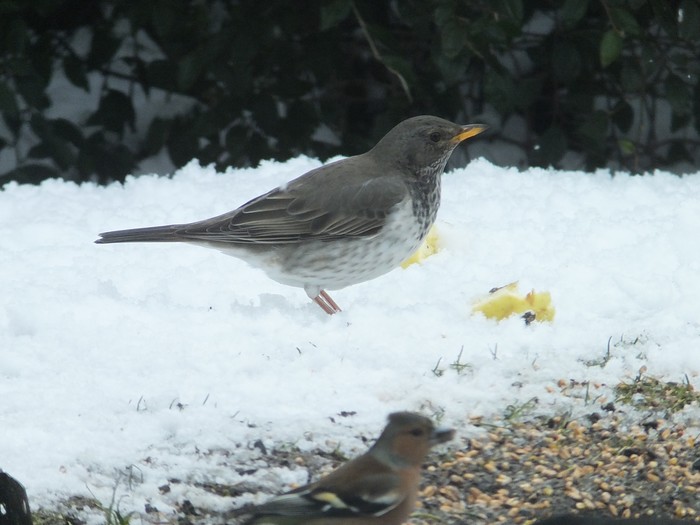
No such problems for admirers of the North Uist Harlequin ~ the young drake still present off Balranald at Traigh Iar for another week.
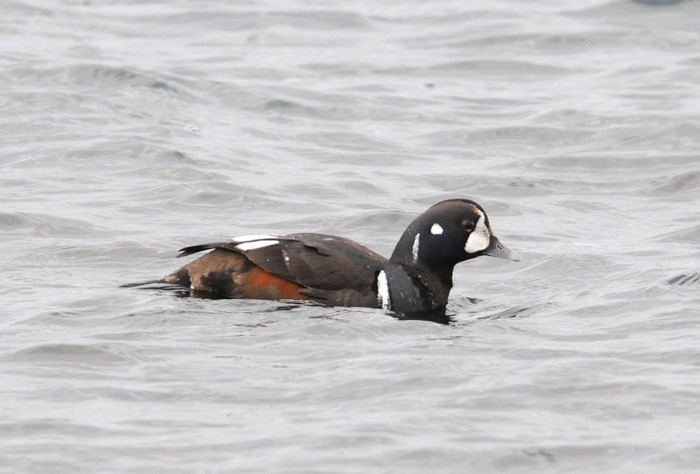
In Somerset, the Pied-billed Grebe continued its prolonged stay at Ham Wall RSPB reserve throughout the week while the Pacific Diver was again in Mount’s Bay (Cornwall) on 1st.
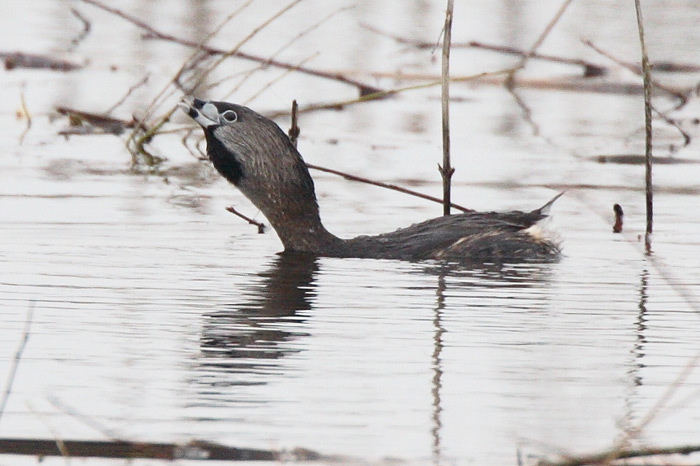
Back over in Ireland the American Coot was at Murlach in County Galway to 30th with the wintering juvenile female Northern Harrier still in residence at Tacumshin (Co. Wexford) to the same date.
The Outer Hebrides started to clock up the White-billed Divers this week ~ a slow start admittedly, but two banana-beaks is most certainly better than a negative showing of this supreme Arctic traveller. Inevitably it was the north end of Lewis that opened up the islands’ account for the spring ~ up to three birds present in the Port Nis to Skigersta area from 27th-1st at least.
In Aberdeenshire, at Portsoy , a further three White-billed Divers were seen on 1st and a single bird was still in the waters off South Ronaldsay (Orkney) on 30th-2nd.
Three Little Auks were noted heading east off Staithes (North Yorkshire) on 28th and a Grey Phalarope was seen from Kelling (Norfolk) on 1st, the same day also seeing a Pomarine Skua heading past Thorpeness (Suffolk).
As has been the recent trend, numbers of Great White Egrets recorded fell away again in the last week.
Three birds were seen together at Summer Leys NR (Northamptonshire) on 28th with presumably the same three relocating the following day to Fen Drayton Lakes RSPB in Cambridgeshire (followed by another at Soham on 1st).
In Derbyshire, a Great White Egret was seen over Carsington Water on 30th and wintering singles remained were seen again at Hale (Cheshire) on 29th and near Horsey (Norfolk) on 31st while in Kent, at Dungeness, two or three birds were seen throughout the week.
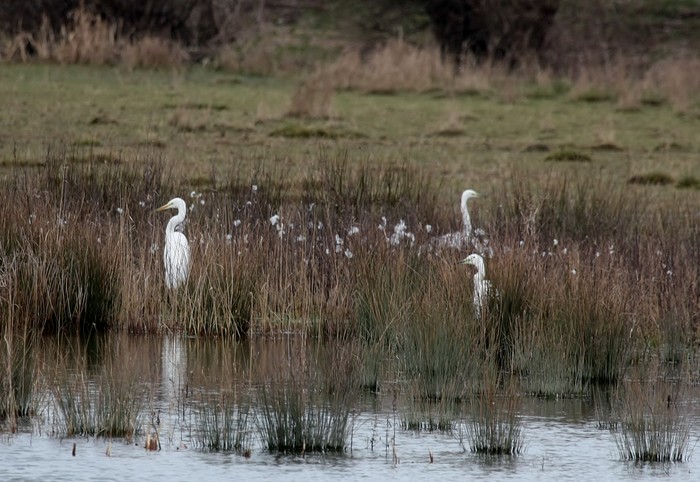
Singles, twos and a three were seen at least four sites in the Avalon Marshes complex over the last seven days, and six were at Catcott Lows on 31st, while Somerset also had a lone bird appear at Highbridge on 29th. A little further in to the Westcountry (but only just!), the Great White Egret at Coate Water Park (Wiltshire) was present to 31st. A further single was reported from Clifton (Bedfordshire) on 1st.
In Donegal, the Cattle Egret at St. Johnston was present to 28th and further singles were reported from Hoveringham (Nottinghamshire) on 28th and in Lancashire, near Morecambe on 29th.
The Welsh Glossy Ibis was at Marloes Mere (Pembrokeshire) to 2nd and what may well have been the Hampshire individual from Warblington appeared at Arundel WWT (West Sussex) on 30th, remaining to the following day before de-camping to Pulborough Brooks on 1st.
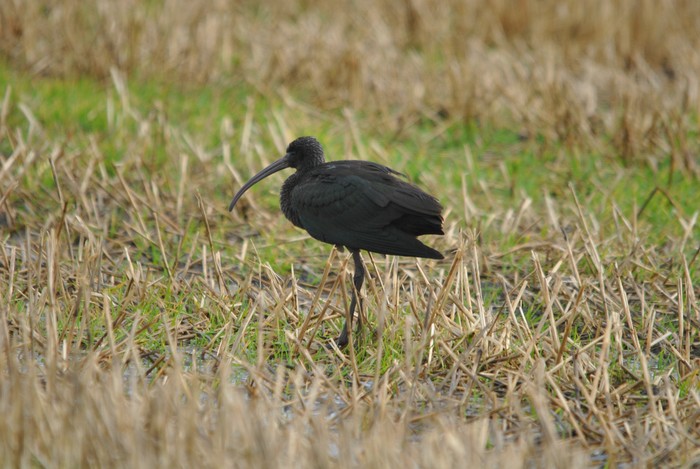
English Channel counties fared well for Spoonbills again this week ~ the largest gathering remained the five birds at Titchfield Haven NNR (Hampshire), which became six on 2nd, with singles elsewhere in the county at Farlington Marshes and Lower Pennington through the week.
There were two groups of four in Dorset ~ at Middlebere on 28th (with presumably the same group at Lytchett Bay the following day) while at Lodmoor RSPB, three rose to four on 29th. Other Dorset birds were noted at Radipole Lake RSPB and also further along The Fleet at Abbotsbury on 28th.
Moving further west in to Devon where groups of three were noted on the Exe Estuary, at Powderham, on 29th (there’d been two along the river earlier in the week) while in the south of the county, a trio of Spooners was on the marsh at South Huish on 31st (after two had been seen at nearby South Milton Ley on 27th). A couple of birds were in the north too ~ seen at Fremington and Wrafton, and Cornwall’s north coast continued to host two birds on the Amble Marshes to 29th.
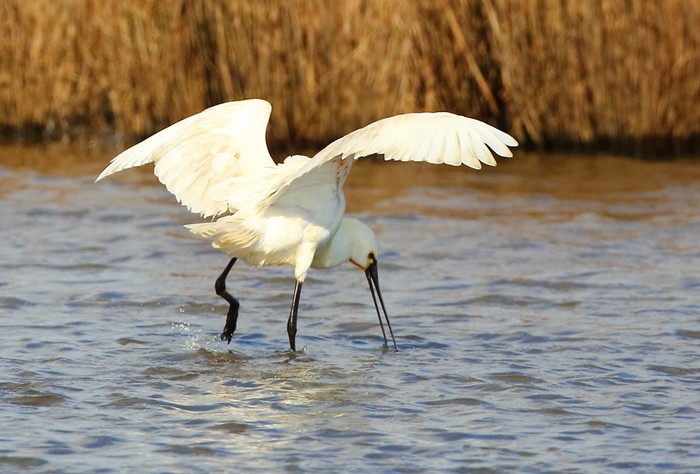
Two Spoonbills were at Cley NWT and then Stiffkey Fen (Norfolk) on 27th-29th, one was again at Pulborough Brooks on 27th and then at Cuckmere Haven (East Sussex) on 29th with the other singles this week noted again at the WWT National Wetlands Centre (Carmarthenshire) to 30th and on Marshside RSPB (Lancashire) throughout the week and an inland bird headed over Amwell GPs (Hertfordshire) on 2nd.
The week began with two Common Cranes heading east over Hassacarr NR (North Yorkshire) on 27th with four birds still near Acle (Norfolk) on the same day. The 28th saw three birds noted near Soham (Cambridgeshire) and two each in Northamptonshire and Leicestershire ~ at Thorpe Waterville and over Rutland Water, the former still present until dawn the next day.
The long-staying first-winter Craneat Tyninghame in Lothian was last seen on 28th and on 29th the week’s largest gathering was noted in the Norfolk Broads, 20 birds seen at Waxham. A single bird was seen over Wicken Fen NT (Cambridgeshire) on the same day with three on 30th in the same county, at Eldernell followed by two at Tubney Fen and five on the Nene Washes on 31st, with three over the county birder in Norfolk, at Welney WWT on the same date.
The other Cranes this week were noted at Appledore (Kent) on 30th, over Abberton Reservoir (Essex) on 31st and four were seen in the Highlands, over Inverness on 2nd.
An unringed White Stork on a lamppost in the middle of a housing estate in Hertfordshire (at Sawbridgeworth) on April 1st may have sounded like a bit of a ruse, but it was the real deal (even if the bird might not have been) and remained in the area, taking to fields eventually before taking to the skies and heading over Bishop’s Stortford and then Braintree (Essex) later the same day.
A stork sp. was also reported at Winterton on the east Norfolk coast over the weekend.
Gwent birders must have been very happy this week ~ the county scored their first-ever Lesser Scaup this week when a drake arrived at Bryn Bach CP, near Tredegar on 27th and remained there to 1st, often showing well. Gwent becomes the third county this month to score the species as a 1st ~ following on from Herefordshire and Derbyshire.
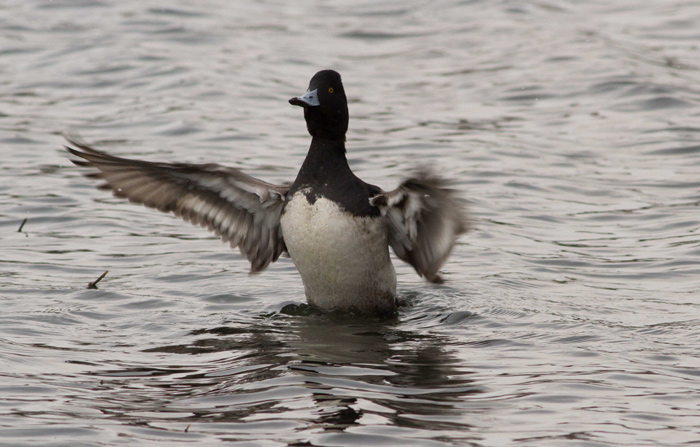
The former of those two birds remained at Wellington GPs to 2nd while the latter, a first-winter drake (which relocated to Lincolnshire’s Freiston Shore RSPB reserve) remained to 2nd.
Otherwise it was very much “as you were” for the remaining four drakes ~ birds remaining across the long weekend at Siblyback Reservoir (Cornwall), Leperstone and Auchendores Reservoirs (Clyde), Oxford Island NNR (Co. Armagh) and again on Cosmeston Lakes CP (Glamorgan).
Three Ring-necked Ducks were again keeping each other company on Tresco between 28th-1st at least and two birds (first-winter drake and duck) were again on Slapton Ley (Devon) on 30th.
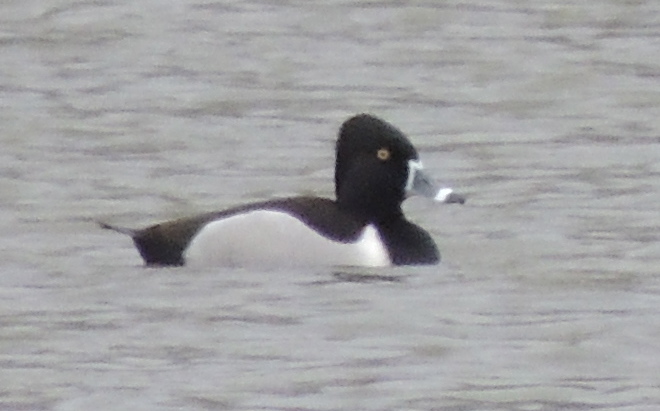
In Cornwall, the wintering drake on Par Beach pool was still present on 28th and the sporadically seen first-winter drake at Marloes Mere was noted again on the previous day, when also drake popped up again on Somerset’s Wimbleball Lake. A drake was then seen on Ashford Reservoir on 1st.
The first-winter drake Ring-necked Duck was at New Arram (East Yorkshire) to 2nd and the female remained around the lochs of North Uist (Grogary and Scaraidh) to 31st at least, while two single drakes were noted in Donegal ~ at Dunfanaghy New Lake on 30th and Lough Shivnagh the following day.
The only Ferruginous Duck recorded this week was the drake that remained at Otmoor RSPB (Oxfordshire) throughout the week.
After seven birds last week, numbers of Green-winged Teals dropped a couple to five over the last seven days. The newbie that was at Stanwick GPs (Northamptonshire) remained to 27th with presumably the same drake reappearing at Irthlingborough on 29th where it stayed to 1st. Other single birds remained at Caerlaverock WWT (Dumfries & Galloway) to 27th, Dunfanaghy New Lake (Co. Donegal) to 30th, Dorman’s Pool (Cleveland) to 31st and on Pennington Marshes (Hampshire) to 2nd.
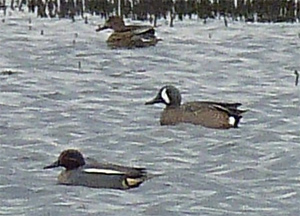
A new drake Blue-winged Teal was found on the Killeton Polder, Ballylongford (Co. Kerry) on 27th where it lingered until 30th at least. The regular drake in Scotland, at Threave Castle (Dumfries & Galloway) was seen to 29th.
The female American Wigeon reported from Aberlady Bay last week (and still present on 27th) was proved to be a female Eurasian Wigeon when the pictures were analysed this week ~ so we were back to an all-male line up again for the past few days. New birds were found at Quoile Pondage (Co. Down) on 29th and Little Neston (Cheshire) on 31st, the latter still present to 2nd.
The other American Wigeons this week were both familiar winter drakes ~ still at Udale Bay (Highland) and near Topsham (Devon) to 28th and 2nd respectively.
On Shetland, the first-winter drake King Eider was seen again in Bluemull Sound, on Yell, on 30th while four of the week’s six Surf Scoters (all of them drakes) were noted around the Scottish coast ~ again off the coast near Stranraer, at Soleburn on 28th-29th, at Luskentyre, Harris (Outer Hebrides) on 30th , in Lothian, at Seton Sands from 31st-2nd and again off Ruddon’s Point (Fife) on 2nd. The other two birds were both seen off Ireland’s east coast ~ still at Ben Head (Co. Meath) and Balbriggan (Co. Dublin) on 29th.
A Todd’s Canada Goose was seen at Port Charlotte, on Islay (Argyll) on 27th and the wintering bird on the Cashen Estuary in County Kerry, recently named as a Todd’s, was still present on 28th.
On the Outer Hebrides, a Richardson’s Canada Goose was present on North Uist on 28th-29th and back on Islay, another was noted at Ardnave on 29th. In Ireland, another was still present at Ballintemple (Co. Sligo) on 1st.
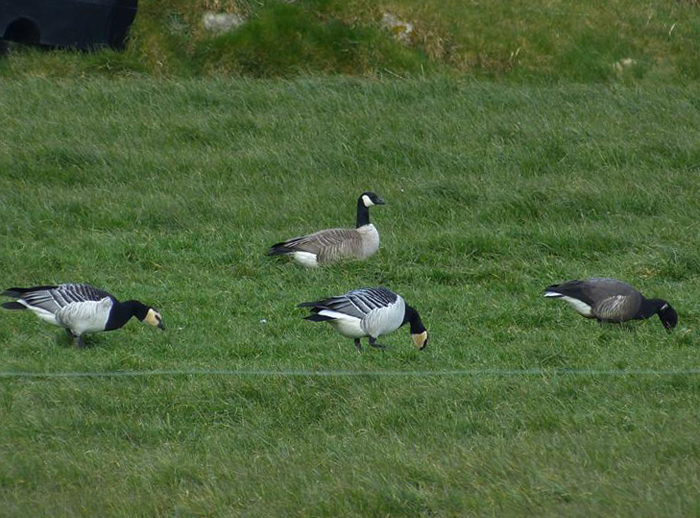
The Snow Goose split this week was two whites to two blue ~ the former colour morphs were still at Sheskinmore Lough (Co. Donegal) and Balranald RSPB, North Uist (to 29th and 2nd) while the blue birds were still at Lower Lough MacNean (Co. Fermanagh) on 30th-1st with a new individual near Lochmaben (Dumfries & Galloway) on 2nd.
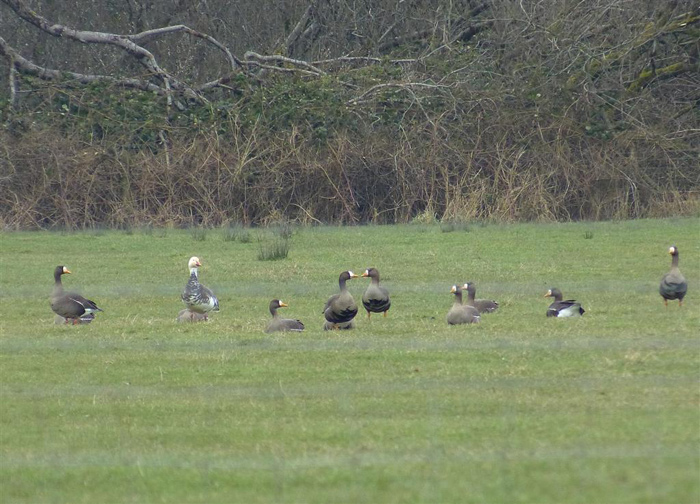
After over a month of no news, the Ross’s Goose of unknown (widely presumed suspect) origin resurfaced this week on the north Norfolk coast ~ seen heading south south-east over Cley village, with 40 Pink-footed Geese, at dusk on 28th it was then back with the group of seven Barnacle Geese and around 20 Pinks the following day on Blakeney Freshmarsh, where it remained to 30th.
The adult Black Brant was still at Kilnsea (East Yorkshire) on 30th when another was noted again at Rosslare (Co. Wexford). The following day saw another Brant appear at The Naze (Essex) while in Hampshire, the Red-breasted Goose and Black Brant were still at Farlington Marshes HWT for a few more days, the former to 2nd.
The two male Kentish Plovers (including the German colour-ringed bird) remained at Rye Harbour (East Sussex) until 29th, with one left on its own to 1st, with the two back together again on 2nd. A striking male was found at Swalecliffe (Kent) on 28th ~ it stayed to the following day ~ while a female was at Ferrybridge (Dorset) on 1st (one was seen here a week before of course).
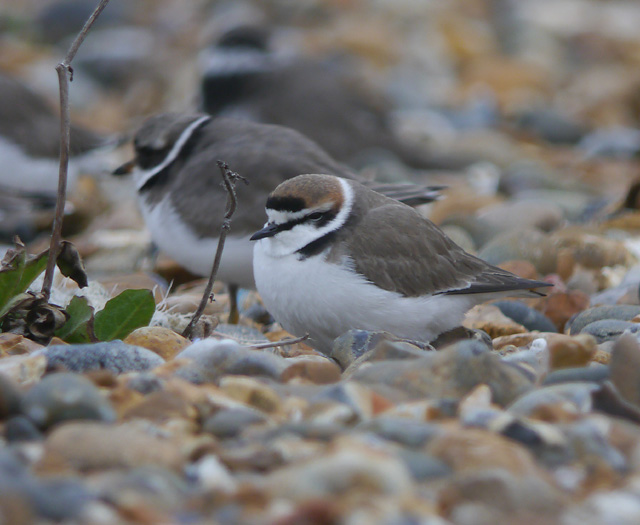
There was no news of any Long-billed Dowitchers or Temminck’s Stints this week, but the Devonian Lesser Yellowlegs did hang on in for another few days, making to April 2nd when a new ‘legs made an appearance on rock pools between Skerries and Balbriggan (Co. Dublin).. .
Aside from a report of three Dotterels near Siblyback Reservoir on 2nd really is slim pickings in Waderworld at the moment….
An adult Bonaparte’s Gull was found at Thurso (Highland) on 30th while the regular adult was still in the Cardiff Bay area (Glamorgan) off and on through the week.
Eleven Ring-billed Gulls were in Ireland during the week ~ three birds (a first-summer and two adults) at Cuskinny Marsh (Co. Cork) on 30th leading the way, followed by three adults in the Dublin area on 29th (including two still at Sandymount Strand). The regular double act remained at Tralee Wetlands (Co. Kerry) to 1st and the third-winter was still at Groomsport (Co. Down) on 31st. The numbers were made up by single adults at Carrickfergus (Co. Antrim) and Nimmo’s Pier (Co. Galway).
An adult Ring-billed Gull was reported on Crosby Beach (Lancashire) on 28th and the Welsh first-winter remained at Neath (Glamorgan) to 31st. In Scotland, three birds were seen ~ the adult still in the Highlands, at Dingwall, to 1st while first-winters were at Angle Park GPs (Fife) on 29th-30th and on Loch of Asta, Mainland (Shetland) on 28th. Best Ring-bill of the week though was the first-summer bird found at Farmoor reservoir (Oxfordshire) in the evening roost on 2nd ~ the first county record since a very sporadically reported bird was on the Thames, at Henley, in 2004.
Two juvenile Kumlien’s Gulls were at Castletown Bearhaven (Co. Cork) on 31st ~ two of five Irish birds noted over the week. A near-adult remained at Cobh to 1st and Donegal saw juveniles reported from Killybegs on 29th and Tory Island on 30th. Two further juveniles were seen on the Outer Hebrides, one each for North and South Uist.
Around 35 Glaucous Gulls were reported during the week, including up to six in Norfolk, with four still in the Sea Palling area ~ three adults and a third-winter still amongst the seaside throng there. Up to eight birds were noted in the Midlands and three were in the northeast ~ with two each still for Chasewater Reservoir (Staffordshire) and Seaton Carew tip (Cleveland). In Ireland, at least 10 Glaucous Gulls were found, including six at Killybegs on 29th.
The week’s Iceland Gull total of 34 was split 22 to Britain and 12 to Ireland ~ Killybegs again scoring highest with four birds there on 29th. Seven birds were seen in the Midlands, two each for Chasewater and also Ogston Reservoir (Derbyshire), while three singles were noted in North Yorkshire.

In Galway, the adult Forster’s Tern was still in the bay at Kinvarra until 28th.
An adult male Snowy Owl must have been an early morning April 1st treat for someone at Solas on North Uist ~ the potential for it to be the same male that was seen at the same spot for month in mid-May to mid-June must be reasonably high…
Up in the Highlands, the male Snowy Owl was still present on Ben Macdui on 2nd ~ winter gear is still highly recommended should be thinking about a mountain ascent.
Playing hide & seek again in west Norfolk was the juvenile White-tailed Eagle, seen this week leaving Roydon Common NWT, in a north-westerly direction, late on 2nd. Assuming we’re talking about the same bird, it was last seen in Norfolk over Cockley Cley on March 19th, not long after coming across the Wash. Is it commuting back and forth between Lincolnshire and Norfolk or has it been keeping a very low profile for the last two weeks?
In Sussex, at Southease, the Barn Owl with a dark-breast was still present on 30th ~ it was last reported in the last week of February when interest in it dropped like a stone when BBRC’s in-house Dark-breasted Barn Owl expert, Paul French, dismantled its features and pronounced it to be a British alba or possibly a Continental intergrade over on Martin Garner’s Birding Frontiers blog.
Interestingly, it seems as though one or two other BBRC members appear to be less-than-convinced with French’s dismissal of the Sussex bird. Ahh, the joys of committee life…
Cornwall saw two reports of Black Kite come in on April 1st ~ which presumably related to the same individual ~ first noted over Wheal Butson, near St. Agnes just after noon, the bird was then seen some three hours later, a little further to the southwest, heading north over Gwithian.
One of Norfolk’s Rough-legged Buzzards remained around the Breydon and Haddiscoe Marshes area until April 2nd, while further sightings were reported from Sheffield and Langsett (South Yorkshire) on 27th and 29th, at Freston Hill (Suffolk) on 28th and Letchworth (Hertfordshire) on 29th.
There’s little doubting that one of the main talking points this week has been the super arrival of a heap of White-spotted Bluethroats along the south coast, hot on the heels of last week’s birds on the Isle of Portland and the Isle of Wight.
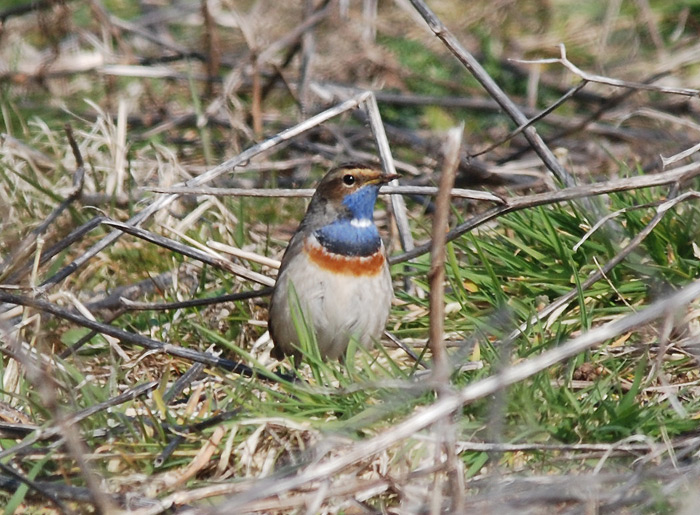
Birders on Portland were treated to not one, not two but three more White-spotted Bluethroats this week ~ four in just over a week is spectacular! The first was a female-type, trapped and ringed at the Observatory on 28th (and re-trapped on 2nd) and she was followed by males in Weston on 30th and in Chesil Cove from 31st.
A little further along the south coast, in Kent, another female was found at Samphire Hoe CP, near Dover, on 27th (she remained to 2nd) with males arriving at Hookers Pit, Dungeness on 31st and St. Margaret’s at Cliffe on 1st (showing again on 2nd).
Devon got in on the act with a stunning male at Prawle Point on 30th, beautifully captured here by long-time Prawle stalwart Pat Mayer and on 2nd, a male was seen briefly in a garden at Melksham (Wiltshire) ~ an outstanding record for the county.
Last but not least, the male White-spotted Bluethroat remained on the Isle of Wight, at St. Helen’s to 1st ~ making this week’s total a splendid nine birds and a figure of 10 individuals within just 11 days, one of the best showings in years.
As well as bagging three Bluethroats, Kent also scored three Penduline Tits this week thanks to the showy male again at Stodmarsh NNR from 30th-2nd and two birds (new ones?) in a small reedbed at Dungeness RSPB on 29th. If they were new, that would crack the Remiz half century for the site…incredible scenes…..
Another new arrival was the Hoopoe at Dawlish Warren NNR on 1st-2nd but that was about it in terms of fresh meat ~ the cool weather meaning that the passerine spotlight fell entirely on to winter treats…
Aberdeenshire finally bide farewell to the female Desert Wheatear at Rattray Head ~ the last date recorded was 26th ~ no sign at all this week, so hopefully she’s on her way, safely to pastures new after a record-breaking 115 day stay (smashing the previous long-stay single-site record set by a first-winter female that spent 67 days near Hayle in January 1995 ~ confusingly it was seen there in mid-December of the previous year, having first arrived at Torpoint in November. The totting up of the total number of days ~ including those when it wasn’t reported ~ the bird was present down Kernow way….114!
Other winter favourites that maintained station this week included the singing male Pallas’s Warbler still on the Berkshire/Hampshire border until 2nd, the first-winter Rose-coloured Starling for the whole week at Exminster (Devon) and two Black-bellied Dippers in Thetford (Norfolk ) to 28th with one present to 30th.
Eleven Great Grey Shrikes included new birds at Whitcliffe (Shropshire) and on Cannock Chase (Staffordshire) on 31st with “regulars” making up the numbers, single birds still present at Therfield (Hertfordshire) to 27th, Llanwonno (Glamorgan) on 28th(with another county bird at Crynant to 2nd), Shatterford, in the New Forest, (Hampshire) to 29th, Thursley Common (Surrey) to 31st, Beeley Moor (Derbyshire) to 1st and in Dorset, at Sixpenny Handley and Morden Bog to 2nd.
The slow advance of spring ensured there was still a countrywide scattering of Waxwings to be had ~ over 3,670 remained around Britain and Ireland, with the southeast being the highest scoring region, some 1,100 bird present in dozens of groups through the week.
Around 163 birds were seen in Ireland (137 in the south, 26 in the north), East Anglia and the southwest of England hosted 190+ and 199+ respectively, with Scotland registering around 265 birds. The Midlands total of just over 400 was boosted by a flock of 100 in Worksop (Nottinghamshire) on 1st, while the northeast scored around 550. The largest groups noted over the past week were in the northwest ~ flocks of 120 in Wigan on 28th and 130 in Orrell on 2nd pushing the regional tally to just over the 800 mark.
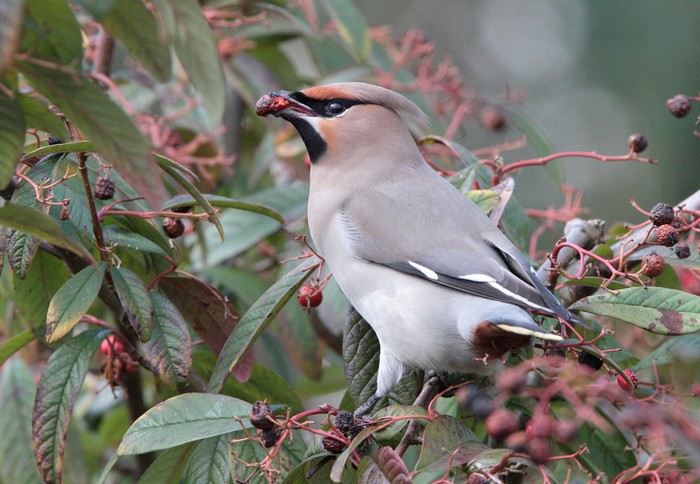
What’s on the cards for next week? The weathermen and women still say chilly, with northeasterlies for a few more days at least, so perhaps east coast birders may strike it lucky and get in on the Bluethroat fun. Taking the groovy little chats up a gear, there have been two early April Red-flanked Bluetails in the 2000’s, so an easterly nudge across the North Sea could be on the cards ~ you never know.
Megas? Well, this time last year, the juvenile Thayer’s Gull in Lincolnshire started to cause a commotion (as best as a gull can ~ larids rock people!) while in 2005, anyone who missed the Belted Kingfisher on A.F.D. had the chance to catch-up with it in Aberdeenshire (and take in Britain’s one and only Amur Wagtail too....). Further back in time, half a dozen Great Spotted Cuckoos have appeared in the week we’re in now and, to top them all, arguably Britain’s Most Wanted...Wallcreeper ~ the famous five-day Hastings bird appearing on April 6th 1977.
A five-day Wallcreeper...what a commotion that would cause....
We can but dream...
Mark Golley
03 April 2013
No otter video for you this week but rest assured they are still there and still entertaining the visitors and inhabitants of Thetford. Instead this week we bring you news of a rare Pinniped on Shetland in the shape of this very fine looking (if a seal can look very fine!) Bearded Seal present at Basta Voe, Yell on 30th. And in a “mammalian-news double header” we bring you news of a Sperm Whale which has been lingering in Oban Bay.






